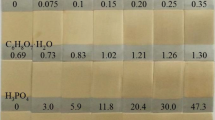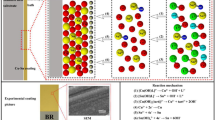Abstract
The requirements for using noncyanide imitation gold plating as decorative electroplating are increasing; thus, continuously improving the quality of the coating of the imitation gold plating and optimizing the coating process have become the current priority. In this experiment, hydroxyethylidene diphosphonic acid (HEDP) was used as the main complexing agent; CuSO4·5H2O, ZnSO4·7H2O, and NaSnO3·3H2O were the main salts; and NaOH and sodium carbonate were used as the buffers to prepare the electroplating solution. Using sodium citrate (SC), sodium potassium tartrate (SS), sodium gluconate (SG), and glycerol (Gl) as four additives, the effects of the number of carboxyl groups on the properties of a Cu-Zn-Sn alloy coating were compared. The electrochemical analysis showed that Cu-Zn-Sn alloy codeposition occurred at -0.50 Vvs.Hg|HgO. The scanning electron microscopy (SEM) results showed that the grain size of the coatings obtained with carboxyl-containing additives was more uniform than that obtained with the electroplating solution without additives. The X-ray fluorescence spectrometry (XRF) analysis revealed that the composition of the Cu-Zn-Sn alloy coating obtained by using SC as an additive in the electroplating solution was 89.75 wt% Cu, 9.61 wt% Zn, and 0.64 wt% Sn, and the color of the coating was golden yellow. The X-ray diffraction (XRD) pattern showed that the coating was a mixture of Cu, Cu5Zn8, CuSn, Cu6Sn5, and CuZn phases. The analysis of the electroplating solution by UV, IR, and NMR spectroscopy methods indicates that the additives improve the coating by affecting the complexation reaction of metal ions. These results can provide technical guidance for developing Cu-Zn-Sn ternary alloy electrodeposition technology with the new cyanide-free HEDP alkaline electroplating system.
Graphical abstract







Similar content being viewed by others
References
Sherif ESM (2012) Effects of exposure time on the anodic dissolution of Monel-400 in aerated stagnant sodium chloride solutions. J Solid State Electrochem 16(3):891–899
Comisso N, Cattarin S, Guerriero P, Mattarozzi L, Musiani M, Vázquez-Gómez L, Verlato E (2016) Study of Cu, Cu-Ni and Rh-modified Cu porous layers as electrode materials for the electroanalysis of nitrate and nitrite ions. J Solid State Electrochem 20(4):1139–1148
Yang SC, Ho CE, Chang CW, Kao CR (2006) Strong Zn concentration effect on the soldering reactions between Sn-based solders and Cu. J Mater Res 21(10):2436–2439
Piccinini N, Ruggiero GN, Baldi G, Robotto A (2000) Risk of hydrocyanic acid release in the electroplating industry. J Hazard Mater 71(1):395–407
Clauwaert K, Binnemans K, Matthijs E, Fransaer J (2016) Electrochemical studies of the electrodeposition of copper-zinc-tin alloys from pyrophosphate electrolytes followed by selenization for CZTSe photovoltaic cells. Electrochim Acta 188:344–355
Almeida MRHD, Barbano EP, Carvalho MFD, Tulio PC, Carlos IA (2015) Copper-zinc electrodeposition in alkaline-sorbitol medium: electrochemical studies and structural morphological and chemical composition characterization. Appl Surf Sci 333:13–22
Rubin W, Oliveira EMD, Carlos IA (2012) Study of the influence of a boric–sorbitol complex on Zn-Mn electrodeposition and on the morphology chemical composition and structure of the deposits. J Appl Electrochem 42(1):11–20
Barbosa LL, Finazzi GA, Tulio PC, Carlos IA (2008) Electrodeposition of zinc–iron alloy from an alkaline bath in the presence of sorbitol. J Appl Electrochem 38:115–125
Barbano EP, Oliveira GM, Carvalho MF, Carlos IA (2014) Copper-tin electrodeposition from an acid solution containing EDTA added. Surf Coat Technol 240:14–22
Almeida MR, Barbano EP, Zacarin MG, Brito MMD, Tulio PC, Carlos IA (2016) Electrodeposition of CuZn films from free-of-cyanide alkaline baths containing EDTA as complexing agent. Surf Coat Technol 287:103–112
Ballesteros JC, Chainet E, Ozil P, Trejo G, Meas Y (2010) Initial stages of the electrocrystallization of copper from non-cyanide alkaline bath containing glycine. J Electroanal Chem 645(2):94–102
Pewnim N, Roy S (2013) Electrodeposition of tin-rich Cu–Sn alloys from a methanesulfonic acid electrolyte. Electrochim Acta 90:498–506
Rudnik E, Wloch G (2013) Studies on the electrodeposition of tin from acidic chloride–gluconate solutions. Appl Surf Sci 265:839–849
Gougaud C, Rai D, Delbos S, Elisabeth C, Daniel L (2013) electrochemical studies of one-step electrodeposition of Cu-Sn-Zn layers from aqueous electrolytes for photovoltaic applications. J Electrochem Soc 160:485–494
Zheng JW, Chen HB, Cai W, Qiao L, Ying Y, Li WC, Yu J, Jiang LQ (2017) Reaction mechanisms of copper electrodeposition from 1-hydroxyethylidene-1 1-diphosphonic acid (HEDP) solution on glassy carbon. A study on electroplating of zinc nickel alloy with HEDP plating bath. Che Mater Sci Eng B 224:18–27
Wang ZL, Yang YX, Zhang JB, Zhu H, Chen YR (2006) A study on electroplating of zinc nickel alloy with HEDP plating bath. Russ J Electrochem 42(1):22–26
Whang TJ, Hsieh MT, Kao YC, Lee SJ (2009) A study of electrodeposition of CuInSe2 thin films with triethanolamine as the complexing agent. Appl Surf Sci 225:4600–4605
Slupska M, Ozga P (2014) Electrodeposition of Sn-Zn-Cu alloys from citrate solutions. Electrochim Acta 141:149–160
Ashworth MA, Wilcox GD, Higginson RL (2014) An investigation into zinc diffusion and tin whisker growth for electroplated tin deposits on brass. J Electron Mater 43(4):1005–1016
Pecequilo CV, Panossian Z (2010) Study of copper electrodeposition mechanism from a strike alkaline bath prepared with 1-hydroxyethane-1,1-diphosphonic acid through cyclic voltammetry technique. Electrochim Acta 55(12):3870–3875
Bonou L, Eyraud M, Denoyel R, Massiani Y (2002) Influence of additives on Cu electrodeposition mechanisms in acid solution: direct current study supported by non-electrochemical measurements. Electrochim Acta 47(26):4139–4148
Leon PFJD, Albano EV, Salvarezza RC (2002) Interface dynamics for copper electrodeposition: the role of organic additives in the growth mode. Phys Rev E 66(4):042601
Dianat A, Yang H, Bobeth M, Cuniberti G (2018) DFT study of interaction of additives with Cu(111) surface relevant to Cu electrodeposition. J Appl Electrochem 48(2):211–219
Lallemand F, Ricq L, Wery M, Bercot P, Pagetti J (2004) The influence of organic additives on the electrodeposition of iron-group metals and binary alloy from sulfate electrolyte. Appl Surf Sci 228(1-4):326–333
Silva FLG, Lago DC, Elia ED, Senna LF (2010) Electrodeposition of Cu–Zn alloy coatings from citrate baths containing benzotriazole and cysteine as additives. J Appl Electrochem 40(11):2013–2022
Ding LF, Liu F, Cheng J, Niu YL (2018) Effects of four N-based additives on imitation gold plating. J Appl Electrochem 48(2):175–185
Carvalho MFD, Barbano EP, Carlos IA (2013) Influence of disodium ethylene diaminetetraa- cetate on zinc electrodeposition process and on the morphology chemical composition and structure of the electrodeposits. Electrochim Acta 109:798–808
Shin S, Park C, Kim C, Kim Y, Park S, Lee JH (2016) Cyclic voltammetry studies of copper tin and zinc electrodeposition in a citrate complex system for CZTS solar cell application. Curr Appl Phys 16(2):207–210
Zhao X, Zhang JJ, Qu JH (2015) Photoelectrocatalytic oxidation of Cu-cyanides and Cu-EDTA at TiO2 nanotube electrode. Electrochim Acta 180:129–137
Ballesteros JC, Chaînet E, Ozil P, Trejo G, Meas Y (2010) Initial stages of the electrocrystallization of copper from non-cyanide alkaline bath containing glycine. J Electroanal Chem 645(2):94–102
Kulyk N, Cherevko S, Chung CH (2010) Copper electroless plating in weakly alkaline electrolytes using DMAB as a reducing agent for metallization on polymer films. Electrochim Acta 59:179–185
Jung M, Lee G, Choi J (2017) Electrochemical plating of Cu-Sn alloy in non-cyanide solution to substitute for Ni undercoating layer. Electrochim Acta 241:229–236
Joint Committee on Powder Diffraction Standards; JCPDS (2000) powder diffraction file- PDF-2 database sets 1-49. ICDD Pennsylvania (CDROM)
Xue L, Fu Z, Yu Y, Tao H, Yu A (2010) Three-dimensional porous Sn–Cu alloy anode for lithium-ion batteries. Electrochim Acta 55(24):7310–7314
He XC, Shen HL, Wang W, Pi JH, Hao Y, Shi XB (2013) Synthesis of Cu2ZnSnS4 films from co-electrodeposited Cu-Zn-Sn precursors and their microstructural and optical properties. Appl Surf Sci 282:765–769
Hsieh MFD, Tsai YT, Su RW, Sun CJ (2014) Electrodeposition of CuZn from chlorozincate ionic liquid: from hollow tubes to segmented nanowires. J Phys Chem C 118(38):22347–22355
Carvalho MFD, Barbano EP, Carlos IA (2015) Electrodeposition of copper-tin-zinc ternary alloys from disodium ethylenediaminetetraacetate bath. Surf Coat Technol 262:111–122
Schah-Mohammedi P, Shenderovich IG, Detering C, Limbach HH, Tolstoy PM, Smirnov SN, Golubev NS (2000) Hydrogen/deuterium-isotope effects on NMR chemical shifts and symmetry of homoconjugated hydrogen-bonded ions in polar solution. J Am Chem Soc 122(51):12878–12879
Sergienko VS (2000) Specific structural features of 1-hydroxyethane-11-siphosphonic acid (HEDP) and its salts with organic and alkali-metal cations. Crystallogr Rep 45(1):64–70
Pecequilo V, Cristiane (2010) Study of copper electrodeposition mechanism from a strike alkaline bath prepared with 1-hydroxyethane-11-diphosphonic acid through cyclic voltammetry technique. Electrochim Acta 55(12):3870–3875
Zheng J, Chen H, Cai W, Qiao L (2017) Reaction mechanisms of copper electrodeposition from 1-hydroxyethylidene-11-diphosphonic acid (HEDP) solution on glassy carbon. Che Mater Sci Engin B 224:18–27
Acknowledgements
This work was supported by the National Natural Science Foundation of China (NSFC51604180), Cultivate Scientific Research Excellence Programs of Higher Education Institutions in Shanxi (CSREP2019KJ038), General Project of Shanxi Province Key R & D Plan (Social Development Field, 201903D321068), and Scientific and Technological Innovation Programs of Higher Education Institutions in Shanxi (2019L0235).
Author information
Authors and Affiliations
Corresponding authors
Additional information
Publisher’s note
Springer Nature remains neutral with regard to jurisdictional claims in published maps and institutional affiliations.
Supplementary Information
Fig S1.
Effect of additives on the surface color of the coatings. BR: 0; SC: 10, 15, 22, 30, 35, and 40 g/L. SS: 5, 10, 15, 20, 30, 35, and 40 g/L. SG: 17.5, 20, 25, 30, 35, 40, and 45 g/L. Gl: 5, 10, 13, 15, 20, 25, and 30 mL/L (DOCX 212 kb)
Rights and permissions
About this article
Cite this article
Chen, C., Ding, L., Li, Q. et al. Effects of four carboxyl-containing additives on imitation gold electroplating Cu-Zn-Sn alloys in an HEDP system. J Solid State Electrochem 25, 1361–1371 (2021). https://doi.org/10.1007/s10008-021-04914-0
Received:
Revised:
Accepted:
Published:
Issue Date:
DOI: https://doi.org/10.1007/s10008-021-04914-0




